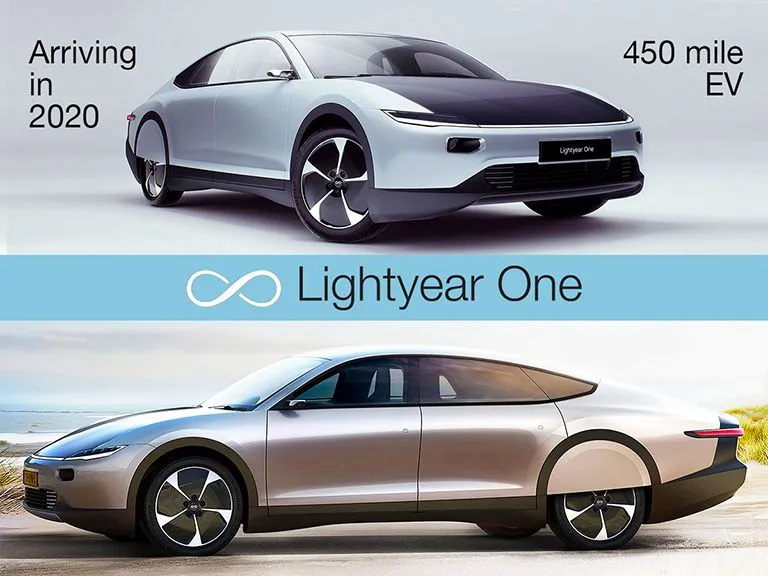
5-seat Lightyear One / 450 pure EV miles / €149,000 / In 2020
Based in Helmond, Holland, a Dutch company has developed a prototype Solar Car named Lightyear One, with a 450 mile range. The car was unveiled in Katwijk, the Netherlands on June 35, 2019. Able to go 0 to 60mph in 10 seconds, it’s fitted with a solar roof and battery system, making it the world’s first solar model with long-range capabilities.
By John Coulter, CMO, Current EV / July 2019
Available from €149,000, the first of the EVs are due to be delivered to customers in 2020. According to the company, its battery system can receive a 400km charge by being plugged into a standard socket for eight hours. The EV is additionally capable of topping up its own battery by self-charging using its rooftop solar array, with Lightyear claiming that motorists will be able to travel up to 20,000km annually on solar power alone while using the model.
Lightyear’s chief executive and co-founder Lex Hoefsloot says: “Climate change is such a frightening development that it’s almost paralyzing. As engineers, we believed we could do something about it. Lightyear One represents an opportunity to change mobility for the better.”
“Since new technology has a high unit cost, we have to start in an exclusive market. The next models we plan to develop will have a significantly lower purchase price. In addition, future models will be provided to autonomous and shared car fleets, so the purchase price can be divided amongst a large group of users. Combined with the low operating costs of the vehicle, we aim to provide premium mobility for a low price per kilometer.”
The futuristic sedan has sleek aerodynamics, wheel-hub motors, and 53 square feet of solar panels on the roof and hood. That could amount to about 795 watts of solar power – about three-quarters as much as is claimed for Europe’s upcoming Song Sion solar-assisted electric car. Lightyear says its sedan roof panels are enough to add 7.5 miles of range per hour on a sunny day. Of course, that would be if the sky is cloudless and you’re driving on an open road with no obstacles blocking the sun.
Lightyear, the company and car, were conceived by a solar race team that competes in the World Solar Challenge, which takes place each year in Australia. Solar Team Eindhoven is tied for the most wins in the race across the Down Under continent. The team, based out of Eindhoven University of Technology in the Netherlands, has been looking to commercialize its technology since 2012.
The sleek five-seat Lightyear One is all about efficiency. Its unique wheel motors eliminate the need for a transmission and allow space for a bigger battery. The styling – reminiscent of a 1980s Citroën CX—was crafted by Italy's Granstudio. With an overall height of just 52 inches, it has among the best drag-coefficients of any EV production car.
The Lightyear One is clearly aimed at a luxury market, rather than mainstream. The company says it will build only 500 of them to start, in 2021, then increase production. That could put it in competition with the Lucid Air and Tesla Model S. Lightyear plans to follow up the model with more affordable, mainstream sedans and to build in some self-driving features in future models.
Recent Posts
- The 2022 Audi Q4 e-Tron SUV combines performance, practicality and luxury
- Ford's 2022 F150 Lightning All-Electric Truck is in high demand
- Legendary Audi performance is at the heart of the 2022 Audi e-tron GT and its RS sibling.
- Meet the Lexus RZ 450e – the luxury brand’s 1st EV
- The 2022 GV60 is Genesis’ first all-electric vehicle

